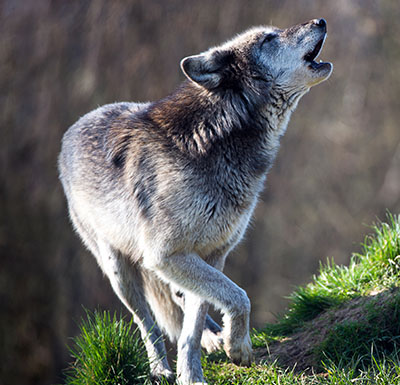"Only the mountain has lived long enough
to listen objectively to the howl of a wolf." ~ Aldo Leopold
In Aldo Leopold’s A Sand County Almanac, there is a section of the book entitled Thinking Like a Mountain, which is an appreciation of the importance of the wolf.
Wolves are a keystone species, meaning they are seen as a vital presence to keeping an ecosystem in balance and healthy.
As Leopold describes, in the absence of an ecosystem’s keystone species the land falls out of equilibrium, as we have watched occur in the Yellowstone National Park.
The Yellowstone Wolves
In 1926, the last of the Yellowstone National Park’s gray wolf population had been eliminated. Their downfall was brought upon by the lack of protection for predators and as being seen as an undesirable species. For the next 70 years the park was free of wolves, until biologists noticed changes occurring in the land and began to wonder if an ecosystem without wolves was a healthy one.
Without the Wolves
- Without the pressure of the wolves, elk population numbers could grow out of control, causing overgrazing
- With the plants gone, the riverbanks eroded affecting the stream ecology
- Aspen trees no longer could grow to their full potential and birds lost their habitat for nesting
- Without the necessary vegetation to build dams and survive, the beaver population dwindled down to only a single colony
- The coyotes became the dominating predator of the park, but couldn’t take the place of the gray wolf due to their smaller size
Along with the gray wolf’s placement on the 1974 Endangered Species Act, the push for a reintroduction of wolves in the Greater Yellowstone Ecosystem (GYE) became a reality. What happened next provided an extremely rare circumstance allowing us to witness the importance of a keystone species.
Eight gray wolves made the journey from Jasper National Park in Alberta, Canada in 1995 to Yellowstone National Park to begin the transformation of the GYE. As of January 2016, an estimated 98 wolves roam the park creating ten wolf packs, and 528 wolves live throughout the GYE.
The reintroduction of the wolves led to a drastic cascade effect throughout the land. One of their greatest impacts was returning the elk population numbers to stability, restoring the balance of the ecosystem.
With the Wolves
- The elk were once again forced to be on the move and retreat to dense woods and higher grounds, driving them away from the riverbanks, giving the vegetation a chance to recover
- With the available resources once again, today nine beaver colonies flourish and morph the landscape
- New wetlands invite the croaking frogs and dancing waterfowl, and the restored water quality brings back swimming trout
- Wildflowers bloom along the refurbished banks providing the nutrients for vast insect populations
- The songs of a birds can be heard again as they collect resources to build their nests
- Coyotes were also driven out saving their small prey such as rodents, foxes, and pronghorn fawns
- A large number of scavengers rely on the wolves’ left over kills for a meal, such as eagles, ravens, coyotes, and even the much larger black and grizzly bears
Not only did the land revitalize and smaller creatures move back in, even the larger mammals benefited from the wolves’ vital role in keeping predator and prey in balance. The howl of the wolves heard throughout the valley remind us of their critical role in the trophic system.
Read How Wolves Affect an Ecosystem Part 2 - Minnesota Wolves Here
References:
- Leopold, Aldo. "Thinking Like a Mountain." A Sand County Almanac. New York: Ballantine Books, 1966. 137-41. Print.
"1995 Reintroduction of Wolves in Yellowstone." Yellowstone Park. N.p., 18 Aug. 2016. Web.
- United States. National Park Service. "Wolves in Yellowstone." National Parks Service. U.S. Department of the Interior, n.d. Web.
"Wolves & Our Ecosystem." Living with Wolves. N.p., n.d. Web.
"Wolf Reintroduction Changes Ecosystem." Yellowstone Park. N.p., 11 July 2016. Web.



